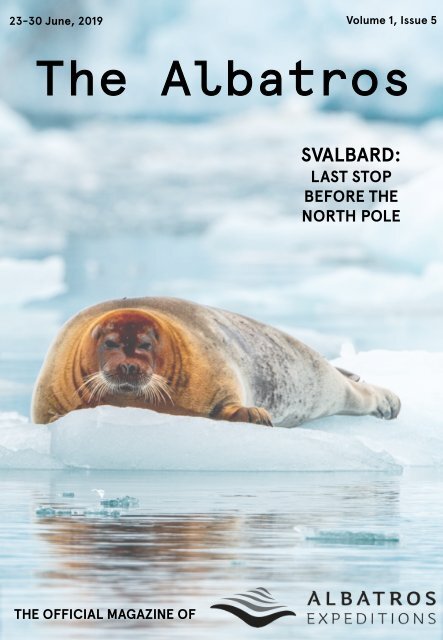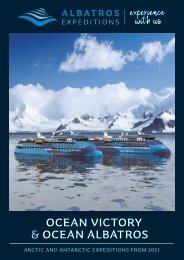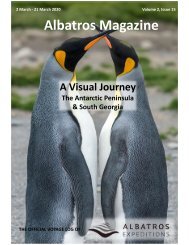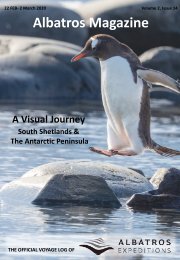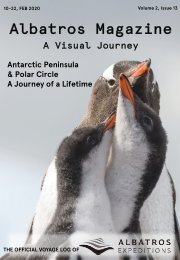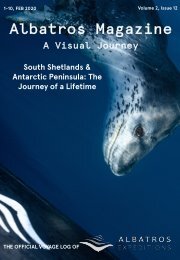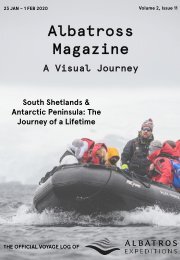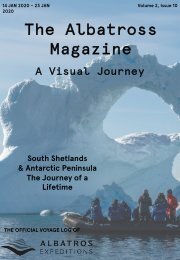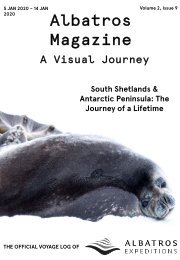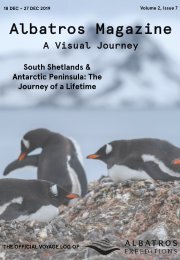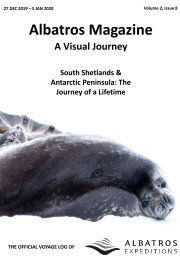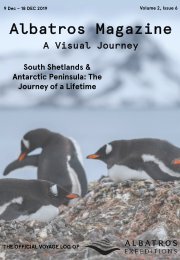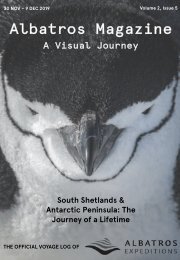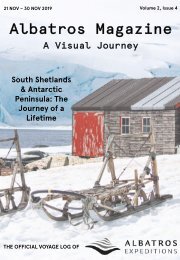Voyage 5 Log
Create successful ePaper yourself
Turn your PDF publications into a flip-book with our unique Google optimized e-Paper software.
23-30 June, 2019 Volume 1, Issue 5<br />
The Albatros<br />
SVALBARD:<br />
LAST STOP<br />
BEFORE THE<br />
NORTH POLE<br />
THE OFFICIAL MAGAZINE OF
The Albatros<br />
Editor-in-Chief:<br />
Staff Writers:<br />
Layout & Design:<br />
Expedition Leader:<br />
Assistant Expedition Leader:<br />
Shop Manager:<br />
Expedition Photographer:<br />
Zodiac Master:<br />
Hiking Master:<br />
Kayak Master:<br />
Rifle Master:<br />
Expedition Guide/Lecturer:<br />
Front Cover Image:<br />
Back Cover Image:<br />
Photography Contributors:<br />
Gaby Pilson<br />
Amanda Dalsgaard<br />
Brian Seenan<br />
Gaby Pilson<br />
Bernabe Urtubey<br />
Steve Egan<br />
Lars Maltha Rasmussen<br />
Nadine Smith<br />
Yuri Choufour<br />
Steve Traynor<br />
Gaby Pilson<br />
Slava Nikitin<br />
Stefano Tricanico<br />
Amanda Dalsgaard<br />
Brian Seenan<br />
Rashidah Lim<br />
Gregers Gjersøe<br />
Wan Meng Chieh<br />
Basha Horyn<br />
Piotr Damski<br />
Thomas Bauer<br />
Diego Punta Fernandez<br />
Bearded Seal © Renato Granieri<br />
Ny-Ålesund © Gaby Pilson<br />
Renato Granieri Photography<br />
Gaby Pilson<br />
Yuri Choufour<br />
© Gaby Pilson<br />
23-30 June, 2019 Volume 1, Issue 5
TABLE OF CONTENTS<br />
The <strong>Voyage</strong><br />
By the Numbers<br />
Day 1: North to the Future<br />
The Seven Sisters of Szczecin<br />
The King of the Arctic<br />
Day 2: Bears & Belugas in Billefjord<br />
What makes an Expedition Guide?<br />
Day 3: Icy Fjords & Scenic Bays<br />
Ice is Nice – Glacier Fun Facts<br />
Day 4: Into the Ice<br />
Svalbard: A Breeding Ground for<br />
Migrant Birds<br />
Day 5: Krossfjord Adventures<br />
A Love Story<br />
Day 6: The Northernmost Settlement<br />
Polar Diplomacy<br />
Becoming an Expedition Guide<br />
Day 7: The Final Days<br />
A Brief History of the Zodiac<br />
Day 8: Home Again<br />
A Final Note<br />
4<br />
5<br />
6<br />
7<br />
8<br />
9<br />
10<br />
11<br />
12<br />
13<br />
14<br />
15<br />
16<br />
17<br />
18<br />
19<br />
20<br />
21<br />
22<br />
23
The <strong>Voyage</strong><br />
Page 4<br />
The following map traces the approximate route that the M/V Ocean Atlantic took during our<br />
voyage around Svalbard. You can find more information about our day to day activities, landings,<br />
and excursions on the following pages. We hope that this magazine serves as a reminder of all of<br />
the wonderful memories you made while experiencing the Arctic with us at Albatros Expeditions.<br />
© Renato Granieri Photography<br />
© Renato Granieri Photography<br />
23-30 June, 2019<br />
Volume 1, Issue 5
By the Numbers…<br />
Page 5<br />
<strong>Voyage</strong> Statistics:<br />
Northernmost Point:<br />
Total Distance Travelled:<br />
79 o 50.541’N, 10 o 08.286’E<br />
578 nautical miles<br />
Longyearbyen: 78 o 12.651’N, 15 o 32.408’E<br />
Smeerenburg: 79 o 44.821’N, 11 o 05.908’E<br />
NW Svalbard: 79 o 50.541’N, 10 o 08.286’E<br />
Möllerfjorden: 79 º 16.502’N, 11 º 51.052’E<br />
Ny-Ålesund: 78 o 54.871’N, 11 o 59.759’E<br />
Alkhornet: 78 o 13.116’N, 13 o 52.718’E<br />
Excursion Locations:<br />
Billefjord: 78 º 28.702’N, 14 º 15.457’E<br />
Magdalenefjord: 79 o 35.485’N, 11 o 18.981’E<br />
Pack Ice Cruise: 79 o 37.137’N, 10 o 21.263’E<br />
14 Julibukta: 79 o 07.554’N, 11 o 48.352’E<br />
Ny-London: 78 o 56.237’N, 12 o 01.548’E<br />
Ymerbukta: 78 o 16.144’N, 13 o 59.390’E<br />
During our time on the M/V Ocean Atlantic, we consumed:<br />
Beef<br />
Lamb<br />
Pork<br />
Poultry<br />
Cold Cuts<br />
Fish & Seafood<br />
Eggs<br />
Milk<br />
Cheese<br />
Ice Cream<br />
Vegetables<br />
Fruit<br />
Wine<br />
Beer<br />
Toilet Paper<br />
400kg<br />
150kg<br />
350kg<br />
350kg<br />
150kg<br />
500kg<br />
4500pcs<br />
500L<br />
200kg<br />
250L<br />
2000kg<br />
2500kg<br />
450 bottles<br />
650 cans<br />
350 rolls<br />
23-30 June, 2019<br />
Volume 1, Issue 5
North to the Future<br />
23 June 2019 - Embarkation Day<br />
As our flights touched down on the runway in<br />
Longyearbyen, we were treated to delightful views of<br />
the Arctic landscape that will become our playground<br />
for the next week. Weary from our early morning<br />
flights, yet excited for the adventure to come, we<br />
immediately journeyed into town for some quick city<br />
exploration in Longyearbyen.<br />
The story of Longyearbyen is short, but industrial,<br />
although it didn’t start out that way. As the history<br />
books tell us, the notion of Longyearbyen as a<br />
potential settlement first came about when John<br />
Munro Longyear was on an arctic cruise with his<br />
family in 1903. While sailing around the many fjords<br />
that make Svalbard the picturesque landscape we<br />
know and love, Longyear spotted some potential coal<br />
mining opportunities in Isfjord. By 1906, he began his<br />
mining operations in what was then known as<br />
Longyear City.<br />
Page 6<br />
From the <strong>Voyage</strong> <strong>Log</strong><br />
© Yuri Choufour<br />
Once we got our fill of the shopping and walking<br />
opportunities in Longyearbyen, we headed off to<br />
the pier to finally embark on our new home, the<br />
M/V Ocean Atlantic, via a short, but exciting zodiac<br />
ride - our first of many on this expedition. After the<br />
hotel check-in process was complete, we were<br />
treated to a scrumptious afternoon tea, before our<br />
mandatory safety drill in the late afternoon. Soon<br />
enough, we were casting away the bowlines,<br />
heading away from our safe harbour, and<br />
journeying out to sea, in true expedition style.<br />
After our safety drill, we had an opportunity to<br />
wander around the ship and acquaint ourselves<br />
with our new home. Before long, however, we<br />
gathered up in the Viking Lounge yet again for an<br />
introductory briefing with Expedition Leader Berna<br />
Urtubey and his 16 expedition staff members.<br />
© Yuri Choufour<br />
Although coal mining is no longer as abundant as it<br />
once was in Svalbard, it has forever left its mark on<br />
the region, least of all by creating the small, but<br />
bustling settlement of Longyearbyen. These days,<br />
however, Longyearbyen is a centre for international<br />
science efforts, tourism, and conservation, and, most<br />
importantly for us: the starting point on our journey.<br />
As we’re on an expedition, we know full well that<br />
there are no guarantees. We are at the mercy of the<br />
weather, the wildlife, and the landscape of this cold<br />
and often inhospitable place. But, as explorers know<br />
all too well, we can only ever experience true<br />
beauty in nature when we are brave enough to seek<br />
it out amongst the mountains and the seas in the<br />
world’s most remote places. It is with that<br />
sentiment in mind that we venture away from<br />
Longyearbyen and north, to the future and all the<br />
wonders it holds.<br />
“<br />
We can only ever experience true<br />
beauty in nature when we are<br />
brave enough to seek it out…<br />
”<br />
© Yuri Choufour<br />
23-30 June, 2019 Volume 1, Issue 5
The Seven Sisters of Szczecin<br />
David MacDonald, Lecturer (Geology) & Expedition Guide<br />
M/V Ocean Atlantic was launched in 1986 as the<br />
last-built of the ‘Shoshtakovich’ class of icestrengthened<br />
passenger vessels, alongside six sister<br />
ships, together known as the “Seven Sisters of<br />
Szczecin.<br />
Her original name was Konstantin Chernenko<br />
(Константин Черненко), after the President of the<br />
USSR (1984-1985). She was renamed Russ (Русс) in<br />
1989, and spent much of her life working in the<br />
Russian Far East.<br />
She was purchased by Albatros Expeditions and<br />
completely refitted in 2017. She is now a 200-<br />
passenger expedition vessel and is one of the<br />
strongest polar cruise ships afloat. Here are some<br />
fun facts about the “Seven Sisters”:<br />
• All seven ships were built by Stocnia Szczecinska<br />
shipyard in Szczecin, Poland between 1979-1986<br />
• Main engines: 4 x Skoda Sulzer 6LZ40 total power<br />
12800 kW, giving a maximum speed of 18 knots<br />
• Most of the class have one bow thruster (736 kW)<br />
and one stern thruster (426 kW); however, two<br />
ships, including ours, built in 1986, have two stern<br />
thrusters, each of 426 kW<br />
• Feature Siemens stabilisers for seaworthiness<br />
• Although built as ferries, they have a<br />
strengthened car deck for transport of tanks<br />
• Two of them had diving chambers<br />
• MV Mikhail Sholokov had hull demagnetising<br />
Page 7<br />
equipment so it could operate in minefields<br />
• All of these ships have been scrapped except ours<br />
and Konstantin Simonov – now Ocean Endeavour<br />
Our ship has had a complex history:<br />
1986-1987 In Baltic traffic, then Vladivostok to<br />
Japan & S Korea<br />
1989 renamed to Russ<br />
1997-1999 In traffic Stockholm-Riga; 2000<br />
Odessa-Haifa; 2002 back to<br />
Vladivostok transporting cars from<br />
Japan<br />
2007 Sold to Sea Ferry Shipping in Majuro<br />
and renamed 2010 to Atlantic;<br />
renovations in Italy and in traffic<br />
Stockholm-Helsinki-St.Petersburg<br />
during summer and laid up (October<br />
2010) in St Petersburg<br />
2012 Sold to ISP in Miami and renamed to<br />
Ocean Atlantic under Marshall<br />
Islands flag<br />
2013 Used as a hotel ship in the German<br />
bight wind farm project<br />
2015-2017 Laid up in Helsingborg and taken to<br />
Gdansk in Poland, where totally<br />
refitted<br />
2017 Chartered to Quark Expeditions<br />
2017-present Chartered to Albatros Expeditions.<br />
© Renato Granieri Photography<br />
23-30 June, 2019<br />
Volume 1, Issue 5
The King of the Arctic<br />
Gaby Pilson, Hiking Master & Expedition Guide<br />
Polar bears are the veritable king of the Arctic, despite their often elusive nature in front of human visitors.<br />
But, despite their cute, cuddly, and charismatic appearance, polar bears are fantastically well-adapted to live<br />
in their harsh Arctic landscape. Here are some great fun facts about polar bears:<br />
1<br />
Although those cute and cuddly little polar<br />
bear cubs look shiny and white in photos, polar<br />
bears are actually black! Polar bears have black<br />
skin with a thick coat of transparent fur rather<br />
than the white fur and skin we’ve always<br />
imagined. The black skin helps the bear absorb<br />
sunlight and retain heat in cold arctic<br />
conditions. Polar bear fur contains no white<br />
pigment and simply appears white because of<br />
how sunlight is reflected off of the bear. This<br />
fur is critical for a polar bear, as it allows them<br />
to hunt while staying well-camouflaged among<br />
snowdrifts.<br />
3<br />
Polar bears are patient hunters. Instead of<br />
chasing prey, they sit and wait for hours or<br />
days at seal breathing holes in the ice until the<br />
opportune moment arises. Seals surface every<br />
five to fifteen minutes at these breathing<br />
holes, so polar bears need to be ready at a<br />
moment’s notice. Luckily, polar bears can use<br />
their acute sense of smell to stalk prey without<br />
expending too much energy. Polar bears will<br />
sniff out a seal from up to a mile away and<br />
through the sea ice, so they can sit and wait by<br />
the right breathing hole. These bears show us<br />
that laziness can, indeed, be a virtue.<br />
Page 8<br />
2<br />
These<br />
graceful bears can be difficult to study in<br />
the wild, as harsh conditions and remote<br />
locales conspire against scientists. Fortunately,<br />
scientists have developed a new technique<br />
that allows them to extract DNA from polar<br />
bear footprints. Using just two tiny samples of<br />
snow from a polar bear footprint, scientists in<br />
Svalbard were able to extract DNA from the<br />
bear and its most recent seal-based meal. The<br />
scientific community hopes that this new<br />
technique can help contribute to research on<br />
polar bears and help make tracking and<br />
monitoring the animals more accurate and<br />
efficient.<br />
© Renato Granieri Photography<br />
23-30 June, 2019<br />
© Renato Granieri Photography<br />
4<br />
After<br />
a long winter in a snow den, polar bear<br />
mothers emerge from their winter homes into<br />
the spring sunshine with up to three cubs.<br />
Although cubs emerge from the den about the<br />
size of a small dog, when they are born, they’re<br />
just 30cm (1ft) long and weigh only 450g (1lb).<br />
Newborn polar bear cubs are blind, toothless<br />
and completely dependent on mum for food<br />
and warmth. They nurse on their mother’s milk<br />
(which is nearly 30% fat!) to help them grow<br />
quickly. Polar bear cubs will continue nursing<br />
for nearly two years until they’re ready to start<br />
hunting and eating seals alongside their<br />
mothers.<br />
Volume 1, Issue 5
Bears & Belugas in Billefjord<br />
24 June 2019 – Billefjord & Adolfbukta<br />
Today, the true ‘Albatros Expedition’ around<br />
Spitsbergan began. As the Ocean Atlantic pulled into<br />
Billefjord, staff and guests, alike, were greeted by over<br />
30 beluga whales swimming along the ice edge. A huge<br />
gift for all spectators, and a fantastic way to kick off<br />
the voyage, the sight of these beautiful beings is one<br />
we won’t soon forget. While some guests witnessed<br />
the beluga pods while enjoying their tea and breakfast<br />
in the Vinland Restaurant, others were up on deck in<br />
the elements, embracing and enjoying the wildlife<br />
show and the surrounding Arctic scenery.<br />
The beluga whale is one of only three whales that<br />
reside in the cold Arctic waters all year-round. They<br />
have adapted physiologically to be fantastic navigators<br />
in their ice-ridden environment with and have honed<br />
their survival abilities to take on the long, dark Arctic<br />
winters. With a strong dorsal ridge, in place of a top<br />
fin, these whales are capable of swimming under the<br />
ice without getting caught up, an advantage for a<br />
species that spends much of its time bumping up<br />
against the ice in search of breathing holes in the cold<br />
winter months.<br />
From the <strong>Voyage</strong> <strong>Log</strong><br />
Page 9<br />
© Gaby Pilson<br />
Once we finished up with our mandatory briefing, we<br />
snuck in a quick boot party to outfit us all with the<br />
rubber boots that we’ll need to stay dry during our<br />
upcoming landings. After the boot part, lunch came<br />
and went, and we soon made our way down to the<br />
gangway for our first excursion of the voyage: a<br />
zodiac cruise around Adolfbukta.<br />
During our zodiac cruise, we managed to spot, once<br />
again, the polar bear from our earlier sighting.<br />
Although our early views of the bear showed it<br />
sleeping soundly, after a short while, the bear got up<br />
for a stretch and a quick jaunt across the remaining<br />
fast ice, perhaps in search of its next meal. One<br />
walrus, and thousands of birds later, however, we<br />
were on our way back to the ship for an actionpacked<br />
evening of lectures, recap, cocktails with the<br />
captain and a scrumptious dinner to wrap up a<br />
fantastic day in the Arctic.<br />
© Yuri Choufour<br />
After this brilliant beluga encounter, the Ocean<br />
Atlantic maintained its position as we came across our<br />
first polar bear sighting of the voyage. The ship was<br />
already placed in a great viewing position, so everyone<br />
could hurry to the outer decks for a view of the<br />
Arctic’s apex predator. Soon enough, however, our<br />
furry friend settled in behind some rocks for a snooze<br />
in the sun, so we carried on with our scheduled<br />
programming and participated in a number of<br />
mandatory briefings for our time in the far north.<br />
© Yuri Choufour<br />
23-30 June, 2019<br />
Volume 1, Issue 5
What Makes an Expedition Guide?<br />
Brian Seenan, Lecturer (Geology) & Expedition Guide<br />
A good expedition guide wants you to enjoy as much as of your<br />
destination as possible. You’ve chosen it carefully and you’re<br />
hungry for information: what do penguins eat, what kind of bird<br />
is that, is that a volcano, why are beluga whales white, does the<br />
sea go all the way around that island? So, we’d better be ready.<br />
Page 10<br />
“<br />
We each have a personal style and<br />
specialisation, but one thing unites us all:<br />
our curiosity for the natural world.<br />
”<br />
We find it so fascinating, we do it for a job. If we’re not guiding,<br />
you’ll find us checking out new and interesting places and<br />
things. Every day, we look forward to learning something new,<br />
like how people lived 5,000 years ago or how seals can delay<br />
gestation, so they only return to shore once to give birth and<br />
mate. This kind of thing fascinates us all.<br />
We want to share this stuff with you, so expect us to be<br />
enthusiastic. We’ll fess up if we don’t know every answer, but<br />
we’ll aim to find it – we don’t like uncertainty any more than<br />
you. We enjoy being with people, and talking about what we<br />
see and feel, even if it’s 2 o C below, with a biting wind.<br />
We take care of you, but not like your mom, and we make sure<br />
you don’t fall out of the Zodiac trying to get a perfect shot of a<br />
puffin. We take courses to drive our Zodiacs well. We learn first<br />
aid, so we can handle the unexpected.<br />
© Renato Granieri Photography<br />
More than anything, we want you to enjoy your adventure.<br />
Everything is there in front of you - the scenery, the wildlife, the<br />
plants and the geology; as guides, we hope we bring them to<br />
life for you.<br />
© Gaby Pilson<br />
© Gaby Pilson © Gaby Pilson<br />
23-30 June, 2019<br />
Volume 1, Issue 5
Icy Fjords & Scenic Bays<br />
25 June 2019 – Smeerenburg & Magdalenefjord<br />
Overnight we travelled north through a gradually<br />
fading mist as we anchored in Smeerenburgfjord, a<br />
wide inlet framed by jagged mountains.<br />
Page 11<br />
From the <strong>Voyage</strong> <strong>Log</strong><br />
The mountains are gneisses and granites dating back<br />
about 1 billion years. Despite their age, their form is<br />
a recent phenomenon, a product of glaciation about<br />
27,000 years ago, during the last glacial maximum. A<br />
massive ice sheet, some kilometres thick, covered<br />
the northern hemisphere and hatched endless<br />
glaciers, which scoured the land. They left the glacial<br />
landforms we learned in school: u-shaped valleys,<br />
hanging valleys, and moraines.<br />
Whalers selected a gently undulating Pleistocene-era<br />
moraine as the centre of their land operations in the<br />
early 1600s. Smeerenburg, literally “Blubber Town,”<br />
was born. Seven Dutch companies and one Danish<br />
company operated ovens to render down whale<br />
blubber for oil. In its heyday, around 200 men<br />
worked here.<br />
© Yuri Choufour<br />
A small team of seven men successfully<br />
overwintered in 1633-34. The following year was<br />
disastrous, leaving another group of seven men dead<br />
from scurvy due to the lack of vitamin C in their diet<br />
up in the far north.<br />
© Yuri Choufour<br />
Arctic terns, eider ducks and guillemots were the<br />
most common birds, though a couple of walrus and<br />
some baby ringed seals popped out of the water and<br />
passed by, eyeing us with curiosity. The other groups<br />
stayed closer to the remains of the ovens and<br />
listened to different experts explain the history and<br />
makeup of the area.<br />
During lunch we repositioned to Magdalenefjord,<br />
which is usually ice-free thanks to the warming<br />
effects of the Gulf Stream. Cruising along in our<br />
trusty zodiacs, we saw a couple of walrus on the<br />
small peninsula near the fjord’s entrance, but most<br />
guests preferred the prospect of seeing<br />
Wagonwaybreen, the glacier at the head of<br />
Magdalenefjord.<br />
While en route to the glacier, we caught sight of a<br />
seal, multiple pairs of eider ducks, lots of guillemots<br />
and the odd tern dipping into the water for a small<br />
fish. A change in cloud cover and freshening of the<br />
wind reminded us that we are in the Arctic. The<br />
temperature dropped by at least 10 o C. It made<br />
sense to retreat to the Ocean Atlantic, to wrap up an<br />
exciting day in Svalbard.<br />
In a world removed from the whalers’ bleak<br />
existence, we scanned for polar bears from the<br />
comfort of M/V Ocean Atlantic before heading to<br />
land, though the constantly changing weather gave<br />
us insight into how difficult life must have been<br />
some 400 years ago.<br />
Some of us enjoyed a fast walk to one end of the<br />
plain, giving us the opportunity to see some bird life<br />
on the water.<br />
23-30 June, 2019<br />
© Yuri Choufour<br />
Volume 1, Issue 5
Ice is Nice – Glacier Fun Facts<br />
Gaby Pilson, Hiking Master & Expedition Guide<br />
Glaciers have, quite literally, shaped our world. Without glaciers, the rolling hills and wide valleys we know<br />
today would look very different, but it turns out that these icy giants have a much longer and more storied<br />
history than many of us would initially suspect. Here are some of the best fun facts about glaciers:<br />
2<br />
4<br />
© Renato Granieri Photography<br />
Glaciers are formed by snowflakes. Although it’s<br />
crazy to think that a tiny snowflake can create<br />
something as large as a glacier, without snow,<br />
glaciers would never exist in the first place. To<br />
form a glacier, massive amounts of snow must<br />
accumulate and persist in a single location all<br />
year-long for hundreds, if not thousands of<br />
years. During this time, the individual snowflakes<br />
found in the snowpack change in a process<br />
known as snowflake metamorphosis, where<br />
individual ice grains fuse together and get bigger<br />
and air bubbles get smaller. Once the icepack<br />
builds up enough mass to start flowing downhill,<br />
then voila! We have a glacier.<br />
© Renato Granieri Photography<br />
1<br />
3<br />
Page 12<br />
Not just anything can be a glacier. In fact, there’s<br />
a size requirement that a piece of ice has to<br />
meet to become a glacier. Anything considered a<br />
glacier must be at least 0.1 km 2 (nearly 25 acres)<br />
in area to be worthy of the name. Although<br />
there’s a minimum size requirement to be<br />
considered a glacier, there’s no upper limit to<br />
glacierhood. The longest glacier on earth is the<br />
Lambert Glacier of Antarctica, which measures<br />
out to some 434 km (270 mi) long. The world’s<br />
largest non-polar glacier is the Fedchenko<br />
Glacier of Tajikistan, which measures a<br />
respectable 77km (48mi) long.<br />
© Renato Granieri Photography<br />
Glaciers are found all over the world, not just in<br />
the polar regions. While the majority of glaciers<br />
and glacial ice is concentrated in high northern<br />
and southern latitudes, glaciers are found even<br />
near the equator, such as on Mount Kilimanjaro<br />
in Tanzania and in the mountains of Ecuador.<br />
That being said, about half of the world’s<br />
200,000 glaciers are found in one place: Alaska.<br />
There, glaciers cover a whopping 72,500 km 2<br />
(28,000 mi 2 ) of the US state’s total area. That’s a<br />
lot of ice.<br />
Glaciers are basically really, really, really slow-moving rivers. To be considered a glacier, a large mass of ice<br />
must be physically moving downhill. This movement downhill is driven by gravity and is the main reason<br />
why glaciers also act as major agents of erosion. Since glaciers move downhill, they often remove and<br />
transport large boulders and chunks of rock, depositing them much further downhill then where they<br />
started.<br />
23-30 June, 2019<br />
Volume 1, Issue 5
Into the Ice<br />
26 June 2019 – Northwest Spitsbergen<br />
From the <strong>Voyage</strong> <strong>Log</strong><br />
Although we were at anchor for most of the evening,<br />
which provided us with an opportunity to get a solid<br />
night of sleep, soon after breakfast, the Ocean<br />
Atlantic made its way north, out of our safe<br />
anchorage in Magdalenefjord and into the ice.<br />
Page 13<br />
The sea ice in Svalbard is a magical place. In the north<br />
of Svalbard, only the bravest and hardiest of ships<br />
journey to the edge of the ice, while even fewer<br />
actually manage to venture into the pack ice itself.<br />
For those who do, however, the experience is surreal<br />
– densely packed ice as far as the eye can see create<br />
the perfect environment for a number of marine<br />
mammals that rely on the ice for a place to rest, a<br />
place to hunt, or both.<br />
While the sheer experience of sailing into the ice is a<br />
worthy enough reason to head north, like any true<br />
expedition, we travelled into the world of ice and<br />
snow for another chance to see the ever-elusive king<br />
of the arctic: the polar bear. Although we didn’t<br />
manage to spot any polar bears, just an hour or so<br />
into our ice-filled adventure, we spotted a trio of<br />
walruses, resting casually on a piece of drift ice.<br />
© Yuri Choufour<br />
Soon enough, however, we were back outside, but<br />
this time, to enjoy the scrumptious arctic barbecue,<br />
compliments of Chef Indra and his talented team.<br />
Braving the polar conditions once again, we<br />
bundled up in our many jackets so we could enjoy<br />
our lunch on the outer decks.<br />
Once lunchtime was all but a distant memory, it<br />
was time for our afternoon activity: a once-in-alifetime<br />
zodiac cruise through the pack ice. With<br />
our trusty zodiacs breaking through small floes of<br />
brash ice, we managed to get up close and personal<br />
with the frozen ocean, before the wind and the cold<br />
beckoned us back inside to the comfort of our ship<br />
once more.<br />
If all of that adventure wasn’t sufficient, soon<br />
enough, we gathered back up in the mudroom for<br />
the ultimate arctic experience: the Polar Plunge. For<br />
the brave few among us, a quick jump into the icy<br />
waters of northern Spitsbergen was a fantastic way<br />
to end a magical day in the ice.<br />
© Yuri Choufour<br />
Thanks to our captain’s skills and the walrus’ close<br />
proximity to the ship, we managed to snap some<br />
great photos of these gregarious mammals – tusks<br />
and all. After a while, however, many of us gave in to<br />
the cold, windy conditions, opting instead to head<br />
inside and warm up with a cup of tea as we listened<br />
to a handful of lectures about a variety of Arcticthemed<br />
topics, from glaciology to marine biology.<br />
© Yuri Choufour<br />
23-30 June, 2019<br />
Volume 1, Issue 5
Svalbard: A Breeding Ground for Migrant Birds<br />
Dr. George Swan, Lecturer (Ornithology) & Expedition Guide<br />
Page 14<br />
© Renato Granieri Photography<br />
In 1594, when the Arctic was first being explored,<br />
Gerrit de Veer, an officer on a Dutch ship, noticed<br />
something strange. While the mammals he<br />
encountered were both new and bizarre (think: huge,<br />
tusked seals and massive white bears), some of the<br />
birdlife was very familiar. In fact, several species of<br />
geese seemed exactly the same as those he had seen<br />
grazing in the Netherlands during the winter. He<br />
hypothesised in his journal: could these birds winter in<br />
the Wadden area and summer in the Arctic? De Veer<br />
knew one thing to be certain, however: they certainly<br />
tasted similarly.<br />
We now know that de Veer’s tentative observation<br />
was spot-on and that the birds he encountered were<br />
probably Brent geese (Branta bernicla) who do,<br />
indeed, winter on the eastern coasts of the North Sea<br />
but spend the summer months breeding in the Arctic.<br />
They make their journey down south and up north<br />
every year and, in doing so, join a whole host of other<br />
migratory birds that make use of Svalbard’s short, but<br />
highly productive, breeding season.<br />
Although the geese arrive to forage on the mosses,<br />
saxifrages and other terrestrial plants, it is the<br />
productivity of the inshore waters and surrounding<br />
seas that draws the biggest crowds. Millions of<br />
seabirds arrive from the Barents Sea and the North<br />
Atlantic to breed on Svalbard’s cliffs and feast on the<br />
zooplankton that blooms in the summer’s 24-hour<br />
daylight. Some come from even further afield; Arctic<br />
terns breed on the coastal flats of Svalbard after<br />
making a staggering journey from their winter foraging<br />
grounds off the Antarctic coast.<br />
Although the summer season is short, and birds must<br />
hurry through the courtship, laying, incubation and<br />
chick rearing processes before the cold weather<br />
returns, those that time it right will head south in<br />
August with that year’s young following close behind.<br />
In acknowledgement of the importance of Svalbard for<br />
breeding birds, 65% of its land area is protected as by<br />
National Parks and Reserves, a testament to the<br />
immense biodiversity in the region.<br />
23-30 June, 2019<br />
Volume 1, Issue 5
Krossfjord Adventures<br />
27 June 2019 – Möllerfjord & 14 Julibukta From the <strong>Voyage</strong> <strong>Log</strong><br />
Page 15<br />
The morning greeted us with clear skies and a<br />
promising forecast. At 06:30, our Expedition Leader,<br />
Berna and his team disembarked the ship to<br />
undertake a scouting mission on the potential<br />
landing site we had chosen for the morning. As soon<br />
as the area was thoroughly scouted, we came<br />
ashore for a beautiful guided walk around the<br />
diverse and intricate Mollerfjord landscape.<br />
The walk was through some rocky terrain, where all<br />
participants had an opportunity to witness some of<br />
the first blossoms of Svalbard’s spring flowers.<br />
Nutrient leaching from the melting snow and ice<br />
provides excellent fertilizer for the ground below.<br />
These flowers are adored by the Svalbard reindeer,<br />
who also made an appearance this afternoon and<br />
provided an excellent encounter for the guests on<br />
shore.<br />
© Yuri Choufour<br />
© Yuri Choufour<br />
© Yuri Choufour<br />
After a fantastic morning, we started our afternoon<br />
with a zodiac cruise along the ridged sedimentary<br />
cliff line adjacent to a breathtaking glacial front,<br />
known as the 14 th of July Glacier (Fortjende<br />
Julibreen) - a significant and beautiful glacier that<br />
got its name from the French national holiday.<br />
Here, we were able to get a close-up view of the<br />
nesting sea birds in the area. There were guillemots,<br />
(both black and Brunnich’s), barnacle geese,<br />
glaucous gulls, kittiwakes, and even a few pairs of<br />
the charismatic Atlantic puffin! As the cruise<br />
continued, the guests got the chance to see a<br />
handful of Svalbard reindeer, sprinkled along the<br />
lichen covered and flower blossoming hillside.<br />
These reindeer are genetically unique to Svalbard<br />
and can be identified by their white fur and often<br />
long antlers. As the afternoon came and went, the<br />
wind picked up and zodiac riders held onto their<br />
seats as the expedition team brought everyone<br />
safely back to the Ocean Atlantic.<br />
After all the guests were onboard, thawed-out and<br />
dry, Lars (Assistant Expedition Leader and<br />
Ornithologist) held a lecture on the longest<br />
migratory species on the planet - the Arctic Tern.<br />
We wrapped up the evening with the daily recap<br />
and plans for tomorrow. Dinner was served while<br />
ship cruising along some incredible glacier fronts as<br />
we worked our way through the night to Ny-<br />
Ålesund, which we planned to make a landing at<br />
and explore first thing in the morning.<br />
23-30 June, 2019<br />
Volume 1, Issue 5
A Love Story<br />
Gregers Gjersøe, Snowshoe Master & Expedition Guide<br />
Anna Charlier and Niels Strindberg were very much in<br />
love in the spring of 1897. Their passion was music and<br />
they often played together; Anna played the piano<br />
while Niels played the violin. But, Niels also had<br />
another passion – his dream to fly to the geographical<br />
North Pole in a hydrogen balloon.<br />
After many years of effort, Niels’ dream was more<br />
than just a fantasy, however, it was an adventure<br />
waiting to happen. Eventually, a three-man crew,<br />
including Niels, Knut Frænkel, and August Salomon<br />
Andree, were ready to set off on the expedition of a<br />
lifetime in their trusty balloon, The Eagle.<br />
In July of 1897, the trio sailed to Danskøya, a little<br />
island in the northwestern part of Svalbard, and<br />
prepared their balloon for the attempt. Although his<br />
working hours were preoccupied with his upcoming<br />
journey while waiting, Niels read a book to pass the<br />
time. The bookmark he used was a card made by<br />
Anna, which showed the three men flying in a balloon<br />
and she had drawn herself. On the bottom of the card<br />
she wrote: “To where I cannot follow”. In his pocket,<br />
Niels kept her portrait and around his neck he wore a<br />
gold heart, complete her picture and a lock of her hair.<br />
On July 11, 1897, the trio took off from their little<br />
island. After the takeoff, the balloon started spinning<br />
and plunged toward the sea. Panicking, the crew<br />
ejected more than 200 kg of ballast, causing the<br />
balloon to fly too high and disappear behind the<br />
clouds. No one heard anything from the trio for the<br />
next thirty-three years…<br />
According to Andree’s calculations, the hydrogen<br />
balloon could stay afloat for at least 30 days, but the<br />
journey came to an end after just 65 hours. The three<br />
men had landed less than a third of the way to the<br />
North Pole, and now had a long way to walk on the ice<br />
back to Svalbard. The trio packed their sledges, but<br />
they were very heavy, making it difficult to walk more<br />
than a few kilometres at a time on the polar ice. Some<br />
days they worked hard for more than 10 hours, but<br />
they made no progress. In fact, they were moving<br />
further and further north, despite their best efforts,<br />
thanks to the drifting ice.<br />
Along the way, Niels kept writing to Anna. On July 24,<br />
1897, he wrote his last letter – a birthday<br />
© Gaby<br />
cardPilson<br />
for<br />
Anna. In it, he wrote that he was in the best of health<br />
and that she didn’t need to worry about the<br />
expedition.<br />
23-30 June, 2019<br />
Page 16<br />
He promised that they would be make it home in<br />
the end. But, due to the drifting ice, Niels was<br />
constantly moving further away from Anna and<br />
toward the North Pole he so desperately wished to<br />
fly to.<br />
Eighty-eight days after they started, the three men<br />
finally made it to a small and isolated island called<br />
Kvitøya by floating on an ice floe. After only a few<br />
days on Kvitøya, all the three men died in October<br />
1897, although no one knows why.There are many<br />
different theories: carbon monoxide poisoning,<br />
polar bear attack, and scurvy, among others.<br />
But, it was only after ten years that Nils was<br />
declared dead. Two years later, Anna married the<br />
Englishman Gilbert Hawtrey, a 38-year-old French<br />
teacher. At the wedding Anna told Gilbert that she<br />
loved him, but her heart belonged to Niels.<br />
Finally, after thirty-three years (1930), the remains<br />
of the three explorers where found at Kvitøya, along<br />
with all their equipment. Niels’ letters to Anna were<br />
found in the camp and, after some examination,<br />
were sent to Anna. The bodies of the three<br />
explorers were brought back to Sweden, where<br />
thousands of people came to welcome them home.<br />
Anna died when she was 78 years old and is buried<br />
in Torquaq. Although she shares the grave with her<br />
husband, Gilbert Hawtrey, there is no heart in her<br />
body.<br />
The 4 th of September 1947 would have been Nils<br />
Strindberg`s seventy-seventh birthday. In the early<br />
morning, without seeking permission from the<br />
authorities, Nils brothers secretly carried out Anna<br />
Charlier’s final wish. After she died, her heart was<br />
operated out of her body and cremated. Without<br />
involving anyone, they opened Nils Strindberg`s<br />
grave and lowered a small silver chest into it. The<br />
chest held Anna Charlier’s heart, a final act<br />
demonstrating the love she had for a wanderlustfilled<br />
arctic explorer.<br />
Volume 1, Issue 5
Page 17<br />
The Northernmost Settlement<br />
28 June 2019 – Ny-Ålesund & Ny-London From the <strong>Voyage</strong> <strong>Log</strong><br />
However, despite its coal mining background, Ny-<br />
Ålesund is one of the most important sites in the<br />
history of exploration of the North Pole. From here,<br />
Roald Amundsen vied with Richard Byrd to be first to<br />
fly over the North Pole. Byrd’s version of events<br />
remains contested, but Amundsen successfully<br />
crossed the pole with an Italian crew, provoking an<br />
argument as to which country should take the<br />
plaudits for the expedition.<br />
© Renato Granieri Photography<br />
Ny-Ålesund’s scenery can only be described as<br />
dramatic - open vistas over Kongsfjord, jagged<br />
mountains topped with sandwich-neat layers of<br />
sediment, and glaciers inching their way to their<br />
inevitable finale on the fjord. What more could you<br />
ask for?<br />
These days, though, Ny-Ålesund is populated only by<br />
a group of international researchers, who use the<br />
town’s northerly location to study vital aspects of the<br />
Arctic’s environment, all of which is coordinated by<br />
the Norwegian Polar Institute.<br />
Few places have such incredible scenery, so Ny-<br />
Ålesund is much different than many of our homes,<br />
though it is somewhat typical of an Arctic settlement,<br />
with its combination of colourful houses and buildings<br />
sitting on top of a raw, barren landscape of gravel and<br />
tundra.<br />
The juxtaposition of the two is both breath-taking and<br />
intriguing, though we took it all in stride; we even<br />
handled disembarking on a quay like professionals: no<br />
beach, no wet landing. It was like a tightrope walker<br />
saying, “Look ma’, no hands!”<br />
Although Ny-Ålesund grew up on coal, only the<br />
remnants of mining remain: the old coal grading<br />
plant, a disused railway track, and a wonky train that<br />
lugged coal from 1917 to 1958, now restored and<br />
going nowhere.<br />
© Renato Granieri Photography<br />
Soon enough, however, it was time to leave Ny-<br />
Ålesund behind. During lunch we repositioned to Ny-<br />
London on the other side of the fjord for a leisurely<br />
walk in the tundra.<br />
As we walked across tundra, we saw reindeer grazing<br />
in the distance, ptarmigans in flight, and snow<br />
buntings foraging on the ground At the lake, we were<br />
treated to some good views of nesting red throated<br />
divers, long–tailed ducks and purple sandpipers, while<br />
overhead we saw arctic terns and a solitary long<br />
tailed skua.<br />
All the while, evidence of a failed mining operation<br />
was more than plentiful, with an abundance of old<br />
machinery, railroad tracks, and other such miningrelated<br />
equipment paying homage to what was once<br />
a major economic focus of the region.<br />
© Renato Granieri Photography<br />
23-30 June, 2019<br />
Volume 1, Issue 5
Polar Diplomacy<br />
Thomas Bauer, Lecturer (Historian) & Expedition Guide<br />
The polar regions of the high Arctic and the Antarctic<br />
are some of the least explored parts of our planet<br />
Earth. Compared to the rest of the world, these<br />
regions have seen relatively few human inhabitants<br />
and their ecology is dominated by snow, ice and<br />
wind. The main inhabitants of these regions are polar<br />
bears, walrus, seals, whales, birds and reindeer in the<br />
high Arctic; and penguins, whales, seals and large<br />
flying seabirds, such as the wandering albatross, in<br />
Antarctica.<br />
The Svalbard Treaty<br />
The Svalbard (formerly known as Spitsbergen)<br />
archipelago and the Antarctic continent have one<br />
important commonality: they have never had a<br />
permanent human population. From this fact arose<br />
the interesting question of who owns these lands of<br />
ice and snow?<br />
In Svalbard this issue was settled on 9 February 1920<br />
when the Treaty Relating to Spitsbergen (Svalbard)<br />
Page 18<br />
was signed in Paris. The archipelago had previous<br />
been declared terra nullius or “no-man’s-land”<br />
because no country had laid claim to it. The Treaty<br />
recognized the sovereignty of Norway over all of<br />
Svalbard but at the same time declared that nationals<br />
of all the other signatory countries (USA, UK with its<br />
dominions, Denmark, France, Italy, Japan,<br />
Netherlands and Sweden) would have equal rights to<br />
those of Norwegians to carry out commercial or<br />
mining operations around the archipelago.<br />
The Treaty also specified that this was to be a region<br />
of peace where, according to Article 9: ‘Norway<br />
undertakes not to create nor to allow the<br />
establishment of any naval base in the territorial<br />
waters of Svalbard’. Thus, was created the first<br />
agreement between states to allow several countries<br />
to enjoy the privilege of using existing resources in<br />
Svalbard while at the same time maintaining the<br />
region as a place of peace.<br />
© Renato Granieri Photography<br />
© Gaby Pilson<br />
© Renato Granieri Photography<br />
23-30 June, 2019<br />
Volume 1, Issue 5
Becoming an Expedition Guide<br />
Gregers Gjersøe, Snowshoe Master & Expedition Guide<br />
Page 19<br />
Back in 1999, I crossed Greenland on skis with two of<br />
my Danish friends. When we finally made it to the top<br />
of the ice cap, we decided to celebrate by flying the<br />
Danish and the Greenlandic flag. Unfortunately, we<br />
ended up placing the Greenlandic flag upside down<br />
because none of us was sure which way was correct...<br />
During the remainder of the expedition, as we made<br />
our way down from the top of the ice cap, I started<br />
thinking more about why and how three Danish guys<br />
could possibly know so little about Greenland, despite<br />
the fact that it’s a part of the Kingdom of Denmark.<br />
When I returned home, I decided to learn all I could<br />
about Greenland and the polar regions, travelling<br />
extensively, not only to Greenland, but throughout the<br />
Arctic and the Antarctic. The polar areas became my<br />
passion and have been for the last twenty years. I<br />
became so fascinated by the polar regions, that I<br />
wanted to share my knowledge and love for these<br />
places with other people. There is so much to love and<br />
experience in the polar regions, from great scenery<br />
and wildlife to the culture of the peoples who have<br />
populated the Arctic since time immemorial.<br />
© Renato Granieri Photography<br />
I haven’t always worked in the polar regions, though.<br />
Since childhood, I was very interested in navigation,<br />
aerodynamics, metrology and aviation. I acquired my<br />
pilot’s license in 1985 and worked as a commercial<br />
pilot for Scandinavian Airlines during a 30 year career.<br />
There, I was able to satisfy all of my interests while<br />
learning how to work as part of a team, bringing the<br />
aircraft from point A to point B in the safest way<br />
possible.<br />
After ending my pilot career, I took up yet another<br />
dream of mine that had occupied my mind since<br />
crossing Greenland. In Danish schools, there is very<br />
little focus on the history and cultures of Greenland<br />
and the Faroe Islands; thus, there is very little<br />
awareness within the Danish population about these<br />
countries. I wanted to create a much better awareness<br />
and, therefore, I started the Polar School<br />
(Polarskolen).<br />
The school is run as a non-profit organization with a<br />
board of nine members. I am chairman of the board<br />
and there are members from the Danish government,<br />
from Greenland, the Faroe Islands as well as teachers.<br />
We have received funding from the Royal Crown<br />
Prince Frederik and his wife, Crown Princess Mary.<br />
Now, I travel Denmark, visiting schools with our<br />
educational materials. Presently we teach 7 th graders,<br />
but we are working towards having materials for 1 st<br />
graders and 4 th graders.<br />
Based on my background and experience in aviation<br />
and in the polar regions, I could not think of a better<br />
way to combine my passions for the Arctic and the<br />
Antarctic then to become Expedition Guide. These<br />
days, I spend five weeks of the summer in the Arctic<br />
and five weeks of the winter in the Antarctic, so I can<br />
show our guests all the places that I truly love.<br />
23-30 June, 2019<br />
© Renato Granieri Photography<br />
Volume 1, Issue 5
The Final Days<br />
29 June 2019 – Alkhornet & Ymerbukta<br />
Page 20<br />
From the <strong>Voyage</strong> <strong>Log</strong><br />
Although the midnight sun and the evening activities<br />
kept us up much too late the preceding night, it’s only<br />
fitting that we to got up early to make the most of our<br />
last full day in Svalbard. After some early morning<br />
pastries and a hearty breakfast, we got our cold<br />
weather gear back on to head out for a final landing at<br />
Alkhornet.<br />
High winds and cold temperatures provided us with a<br />
true arctic experience, as we bundled up for the<br />
bumpy zodiac ride to the landing site. As soon as we<br />
completed the steep, but thankfully short, climb up to<br />
the tundra-covered plateau, however, we were<br />
treated to some stunning views of a staggeringly tall<br />
bird cliff and the surrounding mountain landscape.<br />
© Renato Granieri Photography<br />
Lunch came and went, and soon enough, it was time<br />
for the afternoon zodiac cruise at Ymerbukta. Our<br />
trusty zodiacs glided through the water, treating us to<br />
stunning views of the surrounding mountains, glaciers,<br />
and tundra-filled landscape.<br />
All in all, Alkhornet and Ymerbukta proved to be a<br />
glorious ending to a fantastic set of excursions during<br />
our voyage around Svalbard. Although we’d love to<br />
stay longer, life has other plans in store for many of us,<br />
so we waved a fond farewell to Svalbard and all of the<br />
adventures its wonderful landscape holds as we<br />
zoomed back to the ship for the final time.<br />
© Gaby Pilson<br />
As we head out on our final guided walk of the trip, we<br />
were treated to excellent views of the Svalbard<br />
reindeer (Spitsbergen’s charismatic ungulate), while a<br />
few of us even managed to enjoy a quick sighting of<br />
the ever-elusive arctic fox.<br />
Whether you were on the lookout for foxes, or were<br />
mesmerised by the abundant wildflowers sprawled<br />
across the tundra, it was hard, however, to miss the<br />
tens of thousands of nesting seabirds high up on the<br />
cliffs of Alkhornet. The cacophony of sounds of each of<br />
these birds as they try to find their nest is one that<br />
we’d be hard-pressed to forget.<br />
Once back on the ship, we enjoyed our last afternoon<br />
tea, a celebratory evening of cocktails and fine dining,<br />
which was capped off by a decadent spread of<br />
chocolate-based deserts to wrap up an amazing<br />
culinary experience, thanks to the talents our head<br />
chef, Indra.<br />
Finally, we packed our bags, organized our belongings,<br />
and prepared for disembarkation the next day and our<br />
journeys home - a bittersweet adieu to the Ocean<br />
Atlantic after a fantastic voyage in Svalbard.<br />
Like all good things, however, our final landing came<br />
to an end. After an equally exciting zodiac ride, we<br />
were finally back on the ship for a well deserved lunch<br />
and break before the afternoon’s activities.<br />
© Renato Granieri Photography<br />
23-30 June, 2019<br />
Volume 1, Issue 5
A Brief History of the Zodiac<br />
Steve Traynor, Zodiac Master<br />
In expedition cruising, the most important tool we use is the Zodiac inflatable boat. These manoeuvrable,<br />
reliable, robust vessels are the workhorse of the expedition cruise industry, from the north of Svalbard to<br />
the southern end of the Antarctic Peninsula. They have a long history – as you can see from the stages<br />
below, many different inventions needed to come together to create the craft we use today.<br />
Page 21<br />
© Renato Granieri Photography<br />
1838 Charles Goodyear (USA) discovered the process for vulcanising rubber (a US patent was granted<br />
in 1844) – this process is used for hardening and strengthening rubber.<br />
1843 Goodyear’s process was stolen by Thomas Hancock (UK) using the process of reverse<br />
engineering; less controversially, Hancock invented the “masticator” – a machine for re-using<br />
rubber scraps – this made the rubber industry much more efficient.<br />
1845 The first successful inflatable boat (Halkett boat) was designed by Lieutenant Peter Halkett<br />
(UK), specifically for Arctic operations. Halkett Boats were used by the Orcadian explorer, John<br />
Rae, in his successful expedition to discover the fate of the Franklin Expedition.<br />
1866 Four men made the first crossing of the Atlantic Ocean from New York to Britain on a threetube<br />
inflatable raft.<br />
1896 The original Zodiac company was founded by Maurice Mallet (France) to produce airships.<br />
1909 The first outboard motor was invented by Ole Evinrude in Milwaukee, Wisconsin.<br />
1912 The loss of the Titanic and subsequent shipping losses during World War 1 proved the need for<br />
inflatable rafts for use as supplementary lifeboats.<br />
1919 RFD firm (UK) and the Zodiac company (France) started building inflatable boats.<br />
1934 The airship company, Zodiac, invented the inflatable kayak and catamaran<br />
1942 The Marine Raiders – an elite unit of the US Marine Corps – used inflatable boats to carry out<br />
raids and landings in the Pacific theatre.<br />
1950 Alain Bombard first combined the outboard engine, a rigid floor and an inflatable boat (built by<br />
the Zodiac company).<br />
1952 Alain Bombard crossed the Atlantic Ocean with his inflatable; after this, his good friend, the<br />
famous diver Jacques-Yves Cousteau, started using them.<br />
1960 Zodiac licensed production to a dozen companies in other countries because of their lack of<br />
manufacturing capacity in France.<br />
23-30 June, 2019<br />
Volume 1, Issue 5
Home Again<br />
30 June 2019 - Longyearbyen<br />
After last night’s end-of-voyage festivities, we<br />
awoke much too early for our final morning on the<br />
Ocean Atlantic. As the Ocean Atlantic pulled into its<br />
anchorage in Longyearbyen, we started the process<br />
of leaving behind the ship and the people we’ve<br />
come to know so well over the past week.<br />
Our bags were packed and stowed in the corridors,<br />
ready for our early-morning busses and flights back<br />
to Oslo, Copenhagen, and everywhere in between.<br />
After seven whole days immersed in the landscapes<br />
and amongst the wildlife of the Arctic, it was time<br />
to return home or to wherever our life’s journeys<br />
bring us.<br />
And so – farewell, adieu, and goodbye. Together we<br />
have visited and incredible and vast wilderness. We<br />
have experienced magnificent mountain vistas,<br />
seen icebergs roll and crack, felt the power of the<br />
elements and seen how quickly they can change.<br />
We enjoyed wonder food and comfortable<br />
surroundings aboard the Ocean Atlantic. We<br />
Page 22<br />
From the <strong>Voyage</strong> <strong>Log</strong><br />
boarded zodiacs and cruised through icy fjords at<br />
the end of the Earth. We have shared unique<br />
moments, held engaging conversations, and<br />
laughed together over beers and coffees. We’ve<br />
made new friends and experienced the power of<br />
expeditionary travel.<br />
We hope the expedition team has helped make this<br />
the trip of a lifetime - one that will persist in your<br />
memories for weeks, months, and years, to come.<br />
Although we must say good-bye to these places we<br />
have come to know and love, it is a fond farewell as<br />
we are all true ambassadors for the Arctic and all<br />
the beauty it holds.<br />
On behalf of Albatros Expeditions, our captain and<br />
crew, the expedition team, and everyone else who<br />
helped make this journey a resounding success, it<br />
has been a pleasure travelling with you. We hope<br />
that you will come back and experience these<br />
wonderful places with us once again!<br />
© Yuri Choufour<br />
23-30 June, 2019<br />
Volume 1, Issue 5
A Final Note…<br />
Page 23<br />
As any good expedition comes to a close, many of us experience the<br />
effervescent excitement that comes when we immerse ourselves<br />
completely in an adventure. Although we all came into this voyage with<br />
our own expectations and personal motivations, on the ship, we quickly<br />
learned that the best plan is the one that we end up doing.<br />
While weather and the landscape<br />
can conspire against us in the<br />
northern latitudes, the right mindset<br />
can make all of the difference.<br />
Wind, rain, sleet, and snow make<br />
no difference when we come<br />
prepared for an adventure and all<br />
the excitement it holds. Whether<br />
you saw what you came for or you<br />
experienced something else<br />
entirely, when you set out on an<br />
expedition, you come for the<br />
mountains and the wildlife, but<br />
stay for people and places you<br />
meet along the way.<br />
Although we all eventually have to<br />
leave behind our beloved Ocean<br />
Atlantic, there are always a few<br />
things we can take home from an<br />
expedition:<br />
• An acceptance and<br />
embracement of adversity and<br />
uncertainty when the natural<br />
world alters our plans.<br />
• A fondness for the wild and a<br />
strong desire to keep remote<br />
natural locations as beautiful<br />
and free as they can be.<br />
• An insatiable interest in learning<br />
more about the people, places,<br />
and cultures in some of the<br />
most remote parts of the world.<br />
As you unpack you bags, you may<br />
find souvenirs and keepsakes from<br />
your journey. Your camera may be<br />
filled with countless photos,<br />
however blurry, of the many<br />
animals and mountains that have<br />
crossed our paths. At the end of<br />
the day, however, what matters<br />
most is the experience of, the<br />
journey to, and the memories of<br />
these wild and wonderful places.<br />
Best wishes from all of us on the<br />
expedition team as you continue<br />
on with your adventures!<br />
Berna Urtubey<br />
Expedition Leader<br />
Lars Maltha Rasmussen<br />
Assistant Expedition Leader<br />
Thank you for experiencing the Arctic with us at Albatros<br />
Expeditions. We hope to see you aboard the Ocean Atlantic<br />
again in the future!<br />
Steve Egan<br />
Assistant Expedition Leader<br />
23-30 June, 2019<br />
Volume 1, Issue 5


